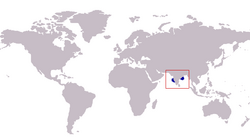Biology:Indian whiting
| Indian whiting | |
|---|---|

| |
| Scientific classification Error creating thumbnail: Unable to save thumbnail to destination
| |
| Domain: | Eukaryota |
| Kingdom: | Animalia |
| Phylum: | Chordata |
| Class: | Actinopterygii |
| Order: | Spariformes |
| Family: | Sillaginidae |
| Genus: | Sillago |
| Species: | S. indica
|
| Binomial name | |
| Sillago indica McKay, Dutt & Sujatha, 1985
| |

| |
| Range of the Indian whiting | |
| Synonyms | |
| |
The Indian whiting (Sillago indica) is a poorly known species of coastal marine fish of the smelt-whiting family Sillaginidae. The species was named in 1985, having previously being misidentified as another species of Sillago, S. parvisquamis. The Indian whiting inhabits the east and west coasts of the Indian subcontinent, apparently not extending to the southern tip of India . Like all sillaginids, it is benthic in nature, living in depths to 30 m where it is caught by fishermen alongside other species of Sillago.
Taxonomy and naming
The Indian whiting is one of over 30 species in the genus Sillago,[2] which is one of five genera belonging to the smelt whiting family Sillaginidae, this family was previously considered to be part of the Percoidea, a suborder of the Perciformes.[3] The 5th edition of Fishes of the World classifies the Sillaginidae in the order Spariformes.[4]
The species was first named by McKay in his comprehensive review of the Sillaginidae, with coauthors Dutt and Sujatha contributing the section on S. indica. The species was previously misidentified as Sillago parvisquamis by the latter two authors in earlier publications, with McKay pointing out the only noticeable difference between the two is the swim bladder morphology, as well as an indistinct black band in the side of the fish.[3] For this reason, the fish goes unidentified in most catches, usually referred to as a number of other sillaginids. The species binomial and common name reflects the species geographical distribution, confined to India only.[5]
Description
As with most of the genus Sillago, the Indian whiting has a slightly compressed, elongate body tapering toward the terminal mouth.[6] The body is covered in small ctenoid scales extending to the cheek and head. The first dorsal fin has 11 spines and the second dorsal fin has 1 leading spine with 21 to 22 soft rays posterior. The anal fin is similar to the second dorsal fin, but has 2 spines with 22 to 23 soft rays posterior to the spines. Other distinguishing features include 68 to 70 lateral line scales and a total of 34 vertebrae. The species has a known maximum length of 17 cm, and possibly longer.[7]
The swim bladder is quite distinct, having a bifurcate anterior extensions, while the anterolateral extensions are recurved and extend to the ventral duct. There is a single posterior extension.[3]
The colour of the Indian whiting is a light tan with a dark brown—blackish band starting behind the upper part of the opercle and curving down below lateral line for approximately two thirds the length and continuing slightly or directly on the lateral line as a broken band or elongate spots. The head, cheeks, belly and lower sides are covered in a sprinkling of black spots. The interspinous membrane of the first dorsal fin, the individual soft rays and the caudal fin are also spotted, with the caudal fin heavily spotted.[3]
Distribution and habitat
As suggested by its name, the Indian whiting is endemic to India , with two populations of the species known, with apparently no movement between these eastern and western populations. The species inhabits inshore coastal waters in a range of depths from 0 to 30 m. Due to its relatively recent naming and difficulty of identification, very little knowledge on the biology of the species has been collected.[7]
Relationship to humans
Like all other species of Sillago, the Indian whiting is taken amongst inshore catches but not distinguished from other sillaginids, with no specific information available on the fishery. It is often taken by drift net, shore seine and cast net by local fisheries, and by mini trawlers.[8]
References
- ↑ Heemstra, P.C.; Lang, N. (2010). "Sillago indica (errata version published in 2017)". IUCN Red List of Threatened Species 2010: e.T154955A115255868. doi:10.2305/IUCN.UK.2010-4.RLTS.T154955A115255868.en. https://www.iucnredlist.org/species/154955/115255868. Retrieved 22 October 2023.
- ↑ Froese, Rainer and Pauly, Daniel, eds. (2023). Species of Sillago in FishBase. June 2023 version.
- ↑ 3.0 3.1 3.2 3.3 McKay, R.J. (1985). "A Revision of the Fishes of the Family Silaginidae". Memoirs of the Queensland Museum 22 (1): 1–73.
- ↑ Nelson, J.S.; Grande, T.C.; Wilson, M.V.H. (2016). Fishes of the World (5th ed.). Hoboken, NJ: John Wiley & Sons. pp. 502–506. doi:10.1002/9781119174844. ISBN 978-1-118-34233-6. OCLC 951899884.
- ↑ Ramesh, S.; P.S. Lyla (2003). "Species (Animals) Named After India". Seshaiyana: ENVIS Newsletter on Estuaries, Mangroves, Coral Reefs and Lagoons 11 (2). http://casmbenvis.nic.in/pdf/Seshaiyana11-2.pdf. Retrieved 2008-07-28.
- ↑ Froese, Rainer and Pauly, Daniel, eds. (2007). "Sillago indica" in FishBase. Aug 2007 version.
- ↑ 7.0 7.1 McKay, R.J. (1992). FAO Species Catalogue: Vol. 14. Sillaginid Fishes Of The World. Rome: Food and Agricultural Organisation of the United Nations. pp. 19–20. ISBN 92-5-103123-1. ftp://ftp.fao.org/docrep/fao/009/t0538e/t0538e07.pdf.[yes|permanent dead link|dead link}}]
- ↑ Dutt, S.; K. Sujatha (1980). "On the seven species of fishes of the family Sillaginidae from Indian waters". Mahasagar: Bulletin of the National Institute of Oceanography 13: 371–375.
External links
Wikidata ☰ Q2450782 entry
 |


